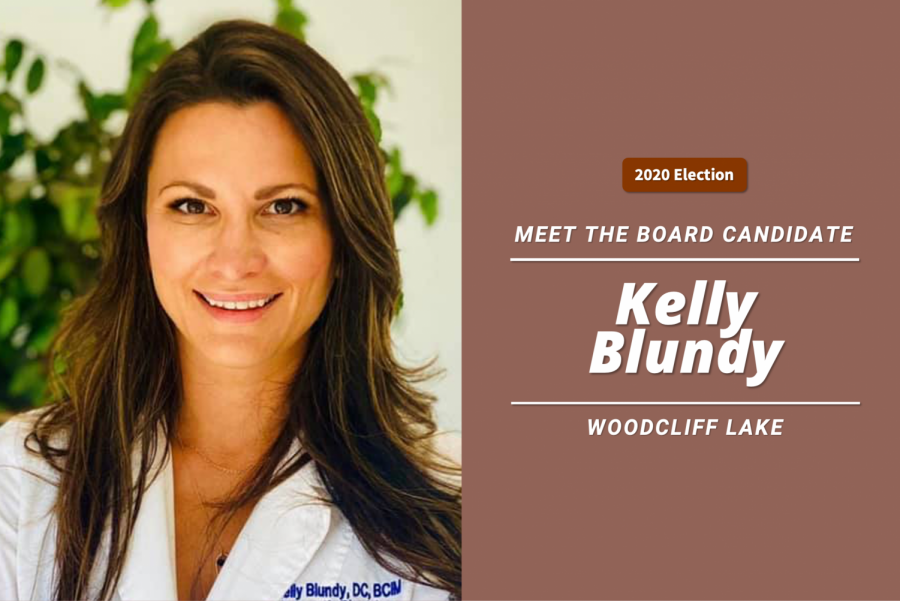
Kelly Blundy is running for the open Woodcliff Lake seat. The other candidate running for the seat is incumbent David Steinberg.
Blundy was born in Buffalo, N.Y., and moved around often throughout her childhood and into adulthood. After obtaining her Bachelor’s in Human Biology and her Doctorate of Chiropactic from Logan University, she began her career as a chiropractor and co-founded The Spine and Health Center of New Jersey with a location in Montvale. Blundy is also a member of the Board of the New Jersey Doctor Patient Alliance (NJDPA).
Blundy has lived in Woodcliff Lake with her husband, Dr. Peter Wohl, since 2008. They have two children, both in elementary school.
She is centering her campaign for the Board around better preparing the district for future emergencies, improving student wellness, and listening to all sides of an argument.
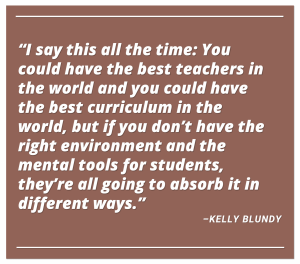 Why Blundy is running
Why Blundy is running
“I have a passion for and background in everything health, wellness, and mental being, especially of our younger generation. It is important obviously throughout all education, but it’s especially important for [high school students] because this is the transition of right before [the students] are ready to go out into the real world,” Blundy explained of her motivation for running.
She continued to say that there is a broader “need to provide better mental health and wellness programs for every student,” because, in her words, “[y]ou could have the best teachers in the world and you could have the best curriculum in the world, but if you don’t have the right environment and the mental tools for students, then there is the possibility that the student won’t absorb the material in an applicable way.”
Read full response
Jared Mitovich: Given the crises we are facing, what motivates you to run for the Board now, and what will be your priorities if you’re elected?
Kelly Blundy: I have a passion for and background in everything health, wellness, and mental being, especially of our younger generation. It is important obviously throughout all education, but it’s especially important for [high school students] because this is the transition of right before you guys are ready to go out into the real world. [When entering] college, people are often [picking a major geared towards] what their job careers are going to be, so I have a passion for wanting to help that.
I firmly believe that we as a whole –– not just our area, but as a whole –– need to provide better mental health and wellness programs for every student. I say this all the time: You could have the best teachers in the world and you could have the best curriculum in the world, but if you don’t have the right environment and the mental tools for students, then there is the possibility that the student won’t absorb the material in a certain applicable way. I want to be able to really help out with that aspect through the Board. I already [contribute and volunteer] for the school, and this will be one step further for me.
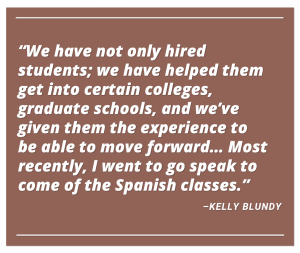 On her involvement with Hills
On her involvement with Hills
Asked to elaborate on the involvement with Hills she cited in her motivation for running, Blundy said her office has participated in the district’s internship program. Blundy said she is also involved with the mental health fairs hosted at Hills and has spoken to some Spanish classes about her travels, which include “a lot of mission trips.”
“I happened to go to Guatemala right before Covid,” Blundy explained, “and I was actually able to come speak to some of the classes on my experience in some of these other countries that are not as lucky as we are.”
Read full response
JM: What kind of stuff do you do for Hills?
KB: Right now, both of my offices for quite some time have participated in the internship program. I think that’s probably one of the best things I’ve seen the school do. I know Jen Errity and Laura Grier sort of run that.
We have not only hired students; we have helped them get into certain colleges, graduate schools, and we’ve given them the experience to be able to move forward. The other thing that’s really cool about that is you also might come into a business as mine or anybody else that participates in the program and go, “Wow, this isn’t for me. I’m glad I knew that before I invested four to eight years of college into it.” So I’m involved in that up at Hills and Valley.
We’ve been involved with a lot of the sports as well. I also do like to get involved with what Mrs. Rossig does with [the students] for the mental health aspect; I’ve been involved in a few of those fairs.
Most recently, I went to go speak to some of the Spanish classes. I like to travel, but I also like to do a lot of mission trips. I happened to go to Guatemala right before Covid, and I was actually able to come speak to some of the classes on my experience in some of these other countries that are not as lucky as we are. Those are just a few examples.
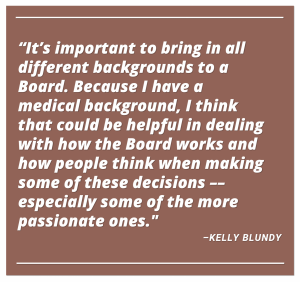 On her experience
On her experience
Blundy described herself as having a medical background, which she said could “be helpful in dealing with how the Board works and how people think when making some of these decisions –– especially some of the more passionate ones.”
Additionally, Blundy is a board member of a large doctors group in New Jersey, which she emphasized has given her experience with teamwork and being open-minded to those who don’t share her same view.
“To be honest, I actually like listening to people who don’t share my own opinion,” Blundy admitted.
She continued, “I have to believe that every candidate running [for the Board] has a common goal, and that is to make sure that we can have the best possible school, faculty, facilities, and a safe learning environment for [current students] and for the future students.”
Later, Blundy added, “I believe from having past board experience and a degree in health care, that I would be considered a good candidate.”
Read full response
JM: In your resume, you described yourself as “one-part Functional Medicine Doctor, one-part Chiropractor, and 10-parts mom/wife, all equaling 100-percent full-time caregiver.” How do these experiences make you qualified to be a Board member?
KB: It’s important to bring in all different backgrounds to a Board. Because I have a medical background, I think that could be helpful in dealing with how the Board works and how people think when making some of these decisions –– especially some of the more passionate ones.
I also have board experience. I am a board member of a large doctors group in the entire state of New Jersey, so I know what it’s like to work with a team.
I have to believe that every candidate running [for the Board] has a common goal, and that is to make sure that we can have the best possible school, faculty, facilities, and a safe learning environment for [current students] and for the future students. I think just from having past board experience and having some of the background that I have, [I would be considered] a good candidate.
I definitely am very open-minded, and I like to listen. To be honest, I actually like listening to people who don’t share my own opinion. I am very open-minded because I always learn something or I change my mind. I think that’s incredibly important to have those qualities, especially for sitting on the board.
JM: Have you had to deal with a lot of differing opinions as a board member of the statewide doctors group?
KB: Absolutely. All the time. The two-hour call I had last night was an example of one of them. Sometimes, topics don’t have to have a long decision; sometimes, they’re topics that people share common knowledge about. They’re easy decisions to be made.
Others are more complicated. It’s about getting people to just calmly, respectfully communicate how they feel, then listen to others, and then after they’ve listened to somebody, ask questions. Not just, “Oh, I’m here to listen to you, and I’ve already had my mind made up.” It’s to go, “Wait a second. So what if you don’t share the same opinion as me.” And I’m talking about the difficult board decisions in my experience. I ask, “Why do you feel that way? Okay, that’s interesting,” and nine times out of ten, we all compromise in a way that is going to benefit, in our opinion, most people. In my situation, it’s patients and other doctors throughout the state.
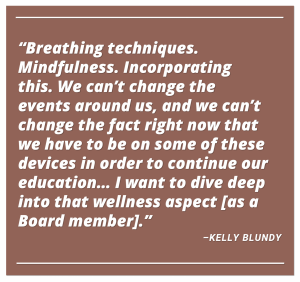 On school reopening and student wellness
On school reopening and student wellness
Regarding school reopening, Blundy explained the specific scientific effects of such drastic changes from in-person to virtual to hybrid learning for both students and staff. She said studies show that this increase in technology use is affecting our decision-making process, which “increases fear, anxiety, and depression” since it makes information more difficult to absorb.
To address this, Blundy said as a Board member she would promote mindfulness and breathing techniques. “We can’t change the events around us, and we can’t change the fact that right now, we have to be on some of these devices in order to continue our education,” she acknowledged. However, she said there were ways to provide tools for students to handle the peer pressure of high school and unique issues that have come with Covid.
Read full response
JM: Moving on to reopening of school. You mentioned you have participated in certain events surrounding student wellness at the school. Additionally, one of the district goals this school year is the following:
“Build upon the district’s student wellness program with a greater emphasis on freshmen transitions and collaboration with partnering districts.”
Are there any specific ways the Board should improve student wellness during a crisis like Covid-19?
KB: Do you have about five hours?
I’m going to get a little scientific. In all of our brains, we have what’s called the amygdala. The amygdala is your subconscious alarm system. It goes, “Bam, we have a threat. We have a threat.” There’s fear; there’s something going on. Your prefrontal cortex is what determines if that threat is really a threat or if you could just go, “Okay, let me take a deep breath and go forward.” I’m explaining this all for a reason. Most of what we’re seeing I like to compare to your amygdala being hijacked. Something happened, and you had an immediate reaction to it. You say something, you do something; oftentimes, we go, “Oh God, maybe I shouldn’t have done that.” And then you have the people who are able to take a deep breath or say, “Okay, this is not an imminent threat. How do I proceed forward in a calm manner?”
To recap, your amygdala is your subconscious alarm, and your prefrontal cortex is your conscious ability to make decisions. So now, we have all of these studies, which were coming out well before Covid, that increased technology atrophies [deteriorates] this prefrontal cortex. Now we’ve gone from in-person learning to remote learning to avoid this disease and take safety precautions, and now, we’re even more inundated with technology, which studies are now showing are affecting our decision-making process.
What does this do? It increases fear, anxiety, and depression. When you add all of that into it, how are you supposed to absorb –– and like I said before it doesn’t matter how amazing the teacher, the curriculum –– how are these students going to be able to absorb this information when you guys are constantly being thrown these curveballs?
What is something you can do about it? Breathing techniques. Mindfulness. Incorporating this. We can’t change the events around us, and we can’t change the fact right now that we have to be on some of these devices in order to continue our education. So working in ways where we can actually destress, take a moment away and learn breathing techniques and mindfulness, can be a tremendous help. Some studies show you can immediately enhance your prefrontal cortex with just five minutes of breathing.
These are a lot of the things I would love to bring in [to the Board] because the subject matter at the end of the day –– not that it doesn’t matter –– is that you want all of the students to be able to absorb this material and calm themselves and be in a less stressed environment. I want to dive deep into that wellness aspect –– and not even just learning. Just the social interactions you guys have. In high school, there’s a lot there’s peer pressure, there’s a lot outside of academics that places a really big stress on you guys. So providing tools to be able to handle that [is what] I’d love to be a part of.
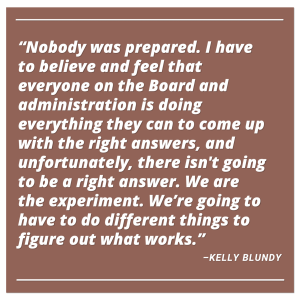 On responding to Covid-19 and future crises
On responding to Covid-19 and future crises
One of the main reasons Blundy cited for her candidacy was her interest in bettering the response to future emergencies like Covid-19, which she said was ill-prepared for but emphasized that it was a responsibility shared by everyone –– not a specific group, school district, or person.
Blundy elaborated, “[T]here needs to be a pandemic virus plan that the entire state of New Jersey follows” to avoid “any confusion” between districts. “We need to have a backup plan so it’s like, ‘Okay, this [crisis] is happening. We as a unified state are going to follow these procedures when we see this happening. This way, it takes out the fear, it takes out the stress and anxiety, and it takes out the disarray because we have a blueprint [of what to do]. It’s something every school has to incorporate now. It’s very important. Kind of like a fire drill –– just a pandemic drill.”
She admitted that in many respects, “[w]e are the experiment. We’re going to have to do things differently to figure out what works.” Blundy said she feels the Board and administration are doing everything they can to come up with solutions.
Read full response
JM: In that vein, you mentioned we can’t really control the events around us. In your resume, you did mention one of the reasons you are running is because of how “ill-prepared we as a society were to handle the current Covid-19 crisis.”
In the future, if a crisis like this happens again, is there anything you would seek to do as a Board member to better prepare the district?
KB: I’d like to speak in terms of the entire state of New Jersey, because it’s very hard to say, “Look at what other countries are doing.” I think we could both agree the population here compared to the population in Montana –– or the atmosphere or the air or the environment –– is very different, so you need to accommodate for those differences.
I mean no disrespect when I mean ill-prepared. I hold myself accountable in that area of being ill-prepared. That’s everybody; that’s not to put anybody down in any way. But there needs to be a pandemic virus plan that the entire state of New Jersey follows to avoid any confusion between districts. We need to have a backup plan so it’s like, “Okay, this [crisis] is happening. We as a unified state are going to follow these procedures when we see this happening.” This way, it takes out the fear, it takes out the stress and anxiety, and it takes out the disarray because we have a blueprint of, [of what to do]. It’s something every school has to incorporate now. It’s very important. Kind of like a fire drill –– just a pandemic drill.
JM: If you could focus on the district, do you think we were prepared for a crisis like this? In a sense, nobody really was.
KB: Nobody was prepared. I have to believe and feel that everyone on the Board and administration is doing everything they can to come up with the right answers, and unfortunately, there isn’t going to be a right answer. We are the experiment. We’re going to have to do different things to figure out what works, and I have to believe not just our district but the entire state of New Jersey –– the entire country –– is trying everything that they can to make sure the curriculum –– remote or hybrid, whatever it may be –– is helpful and effective for all students.
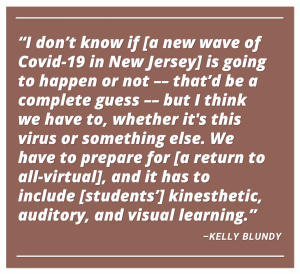 On a possible return to all-virtual instruction
On a possible return to all-virtual instruction
One potential “emergency within an emergency” is a return to all-virtual instruction if a second wave of Covid-19 forces schools to close their buildings once again.
Asked if she is anticipating this to be an immediate concern if elected, Blundy said, “[w]e have to prepare for that, and it has to include [students’] kinesthetic, auditory, and visual learning. Somehow, it has to incorporate that, so even if we’re at home, we have to be able to get up. We have to be able to get physical education; that has to be part of the curriculum.”
Blundy cited her experience with her own children moving to Zoom classes, returning to her main focus of student wellness. “We can do mindfulness with these kids. We can talk about proper food and eating habits and things like that to enhance brain function and decrease stress. These are all things we can do so that we’re calmer, better versions of ourselves,” she explained.
Read full response
JM: Considering the possibility of a second wave this winter, you could be elected and join the Board as the district experiences a switch to all-virtual instruction all over again. Are you anticipating or planning for this to be a primary area of concern if you become a member? Is it something you are preparing for?
KB: I think we have to. I don’t know if [a new wave of Covid-19 in New Jersey] is going to happen or not –– that’d be a complete guess –– but I think we have to, whether it’s this virus or something else. We have to prepare for that, and it has to include [students’] kinesthetic, auditory, and visual learning. Somehow, it has to incorporate that, so even if we’re at home, we have to be able to get up. We have to be able to get physical education; that has to be part of the curriculum, and the great thing about high school students –– this is a lot easier for you guys –– is that you guys can get up and do these things. This is definitely something that’s harder and more difficult for elementary school kids or younger kids.
JM: I can imagine you’re saying that last part from experience as the parent of an elementary school kid?
KB: When this happened, my daughter was in preschool, my son is in kindergarten, and we’re getting on Zoom, and I’m trying to still get my preschooler to not bang the keys and break the computer. So that definitely put a damper.
The school did what they needed to do. That’s not a reflection on the school in any way; it was the right thing to do. But now, how do we go forward? We can do mindfulness with these kids. We can talk about proper food and eating habits and things like that to enhance brain function and decrease stress. These are all things we can do so that we’re calmer, better versions of ourselves. I keep going back to the wellness stuff, but that is where I find the added value.
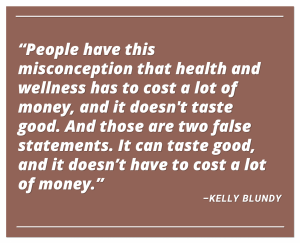 On the budget and Board transparency
On the budget and Board transparency
Blundy said she would be willing to place funds behind these student wellness initiatives if elected unless “there’s something that’s unknown to me that I’m unaware of” that would make it unbeneficial.
“The interesting thing is a lot of this stuff like breathing doesn’t cost money,” Blundy said. “You just have to learn how to do it. People have this misconception that health and wellness has to cost a lot of money, or that it doesn’t taste good. And those are two false statements. It can taste good, and it doesn’t have to cost a lot of money.”
Read full response
JM: A good part of being on the Board is deciding where funds should go, what to fund more or fund less –– or at least proposing those ideas. Would you be willing to divert more funding to promote the things you’re mentioning such as mindfulness and healthy eating habits?
KB: Absolutely. I don’t see how that wouldn’t be a benefit for all. I can’t imagine that unless there’s something that’s unknown to me that I’m unaware of. I can’t see why the Board or parents or even students wouldn’t want that as part of a wellness program.
The interesting thing is a lot of this stuff like breathing doesn’t cost money. You just have to learn how to do it. People have this misconception that health and wellness has to cost a lot of money, or that it doesn’t taste good. And those are two false statements. It can taste good, and it doesn’t have to cost a lot of money.
Regardless of funds, the biggest thing is transparency. There needs to be more transparency, whether its health and wellness or whatever the topic may be. I think that is key. Everyone wants more transparency, to see where the funds are going and how it’s being spent.
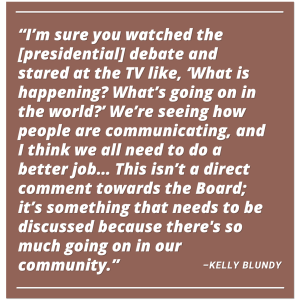
After Blundy spoke with the Trailblazer, the Board unveiled its communication plan for the school year. At the time, she said the Board has to work with the circumstances given to them in order to “communicate better with the community and also have everybody’s voices heard.”
Specifically, Blundy wants to highlight “respect and calmness,” because “[y]ou don’t have to be a certain gender, have a certain religious background or nationality to have respect and values.”
Blundy emphasized that the country as a whole could be a “little bit kinder,” citing the unwieldy presidential debate between President Donald Trump and former Vice President Joe Biden.
“There are so many opinions, whether there are signs out or not… and I feel like we’ve come upon this age where if you don’t agree with everything I say, ‘you’re bad’. ‘You’re a bad person,'” Blundy stated. “I would hope the actions of the Board –– of any board, any leadership team –– speak louder than their words, so we need to be able to demonstrate that in order for the community to follow.”
Read full response
JM: You led me right to my next question. One of the Board’s goals this school year is the following:
“Establish a Board of Education communications committee. Plan for more frequent communications from the board, including a board-specific newsletter to the community regarding reopening and the operations of board of education.”
Do you see communications and transparency as a current fault of the Board of Education?
KB: I don’t think it’s a particular fault of the Board of Education. I think given certain circumstances right now, with Zoom and no in-person and limiting the number of people that can be part of something. That is by no fault of them that we all can’t gather in large places and come together. I think it’s just a very difficult time to be able to do that. That’s something we need to work on. We need to work on ways we can communicate better with the community and also have everybody’s voices heard. Respect and calmness need to be highlighted –– that is big. You don’t have to be a certain gender, have a certain religious background or nationality to have respect and values. That is something I think everybody, not just particularly the Board, could be reminded of every day: to just be a little bit kinder. That’s all.
JM: The way you’re emphasizing respectful and kind brings me to ask: Is there an event in particular that convinced you we need more of that or have you always thought that way?
KB: It is who I am a person. I am a relatively positive person. That is not to say I don’t have plenty of ups and downs and stress in my life. But I choose love over hate every day. I just don’t think we have to be so nasty to each other.
Again, a lot of these answers I’m saying are not directed at the Board. This is our country as a whole. I’m sure you watched the [Sept. 29 presidential] debate and stared at the TV like, “What is happening? What’s going on in the world?” We’re seeing how people are communicating, and I think we all need to do a better job. All of us. This isn’t a direct comment towards the Board; it’s something that needs to be discussed because there’s so much going on in our community.
There are so many opinions, whether there are signs out or not… and I feel like we’ve come upon this age where if you don’t agree with everything I say, you’re bad. You’re a bad person. I would hope the actions of the Board –– of any board, any leadership team –– speak louder than their words, so we need to be able to demonstrate that in order for the community to follow.
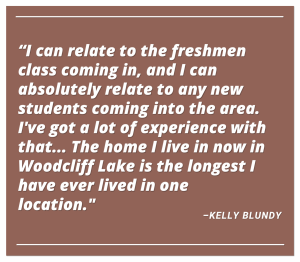 On being the ‘new kid’
On being the ‘new kid’
“The home I live in now in Woodcliff Lake is the longest I have ever lived in one location,” Blundy said after detailing her experiences going from one school to the other during her childhood.
“I definitely know the stress of change” and being a new kid, she expressed. “I can relate to the freshmen class coming in, and I can absolutely relate to any new students coming into the area. I’ve got a lot of experience with that.”
Read full response
JM: You mentioned there is a wider problem than only the Board. Another one of the district’s goals this school year is to advance equity and inclusivity. Firstly, do I have it correct that you have lived in multiple states and countries?
KB: You ready for this? I was born in Buffalo. Then we moved to Toronto, Canada. Then we moved to an island called Grand Island, N.Y., which is an island on the Niagara River in between Niagara Falls and Buffalo. Thank God that island was put, or we would have all gone over the falls.
Then I moved to Hudson, Ohio, Then I moved to Annandale, N.J. Those two periods –– and this is super important –– I was the new kid in sixth grade, and then I was the new kid in eighth grade, so I was the new kid twice in middle school. I definitely know the stresses of change. Then I was the new kid again in middle school when we moved to Michigan.
My brother actually went to three different high schools during that period of time of us moving so much. I can relate to the freshmen class coming in, and I can absolutely relate to any new students coming into the area. I’ve got a lot of experience with that. Then I was in college.
My undergraduate school was in Michigan, and my graduate school was in Chesterfield, Mo. near St. Louis. That’s where I met my husband, who is from Rockland County. Then we moved to Edgewater and then to Woodcliff Lake. The home I live in now in Woodcliff Lake is the longest I have ever lived in one location.
JM: I can’t relate having lived in the same house for basically my whole life.
KB: Neither can my husband.
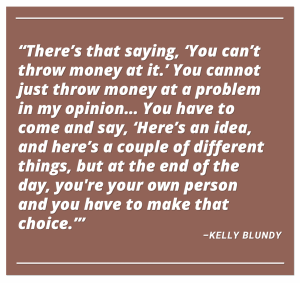 On equity and inclusivity
On equity and inclusivity
Blundy said a particularly impactful experience with equity and inclusivity was a mission trip she took to Guatemala. On the trip, Blundy said she saw “the first generation of change” after an organization called Casa Guatemala taught Indigenous peoples about the other options that they could pursue if they chose to.
“Yes, they need money,” Blundy said of the people she met, “but they need the education. We need to be educated on what we’re working with, and they need to be educated on all these other options that they have.”
The best part of her experience, Blundy explained, was that “the majority of [the tribe members] made the choice that they were happy with” on the life they were interested in pursuing.
“There’s that saying, ‘You can’t throw money at it.’ You cannot just throw money at a problem in my opinion. You need to educate both sides, and you can’t just come in [forcefully] and be like, ‘I have the answers, and I’m going to ram this down your throat.’ You have to come and say, ‘Here’s an idea, and here’s a couple of different choices, but at the end of the day, you’re your own person and you have to make that choice.'”
Read full response
JM: That is a unique experience, which is why I am curious how it impacts your perspective. As mentioned, one of the Board goals is regarding inclusivity and equity. You’ve also been to Guatemala on mission trips. What have those experiences taught you about inclusivity and equity?
KB: Education is key. I know that sounds so cliche since I’m running for the Board of Education, but I’ll give you an example of Guatemala.
If you walk in there, you go into this country, and you go to the tribes, you see a lot of young women pregnant. Now you could [look at that] a whole lot of different ways, so I had to educate myself on what that meant. Actually, what it meant is that for women in those countries, a sign of their menstruation is to reproduce; plus, a lot of their survival is through agriculture. They need people to work the fields, so this is what these young girls and boys are taught.
I learned this through an organization called Casa Guatemala; it’s an orphanage and it’s a school. What [Casa Guatemala] taught them is that if this is what you want to do, okay, but here are all these other options. You could go to trade school. You could become a nurse and provide medical care to your community. You could learn better agriculture and growing techniques so you could grow better crops. You could become an electrician, a plumber.
What was really cool was that, when I got there, I was able to see the first generation of change. I got to see the people who became nurses, who came back. They had plumbers come in and put a clean water filter supply in –– if we looked at it we’d be like, “Oh my God, this is their definition of clean water?” and we’d probably faint, but it was better than what they had currently had to deal with. It was such an amazing experience to see that.
Yes, they need money, but they need the education. We need to be educated on what we’re working with, and they need to be educated on all these other options that they have.
And the best part was, you have the choice. You are given the choice at the end of the day to choose your path, but these are your options for what you could do. Really, Jared, it was one of the most unbelievable experiences of my life.
JM: I can believe that.
KB: There’s that saying, “You can’t throw money at it.” You cannot just throw money at a problem in my opinion. You need to educate both sides, and you can’t just come in [forcefully] and be like, “I have the answers, and I’m going to ram this down your throat.” You have to come and say, “Here’s an idea, and here’s a couple of different choices, but at the end of the day, you’re your own person and you have to make that choice.” And the wonderful thing is that the majority of them made the choice that they were happy with, so it was their good choice.
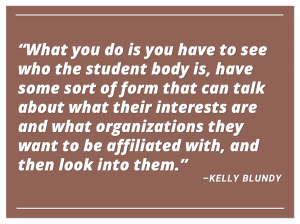
Turning to policies the district could pursue to increase equity, Blundy said she did not have any specific organizations in mind but said the important thing was to “see who the student body is, have some sort of form that can talk about what their interests are and what organizations they want to be affiliated with, and then look into them.”
“As long as those organizations’ goals come from a place of love, education, values, and respect, then those would be the organizations that we should be a part of,” Blundy continued.
Read full response
JM: Based on that, taking it to the school district level, are there any areas of focus in terms of equity that you would seek to prioritize, whether it be changing curriculum to better incorporate both sides, funding programs to promote diversity… Are there any specific programs you would seek to implement to make the district more equitable?
KB: I don’t have an actual organization in mind. What you do is you have to see who the student body is, have some sort of form that can talk about what their interests are and what organizations they want to be affiliated with, and then look into them.
For example, I keep going back to Casa Guatemala because it’s my experience, but I didn’t know until someone said, “Hey, I have a passion for this. Are you interested?” I said, “Yeah, I’m interested. Wow, that’s really cool.” There are billions of organizations out there, and it’s important to get the student body involved every year, to talk about, “Hey, this is what I’m feeling. This is where I’d like to focus my energy.” Why can’t we break off into different groups and have these groups of multiple organizations that we’re supporting and being a part of [sic].
As long as those organizations’ goals come from a place of love, education, values, and respect, then those would be the organizations that we should be a part of.
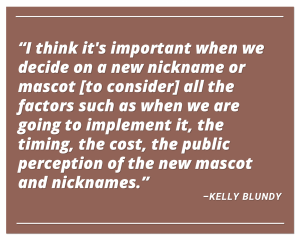 On the mascot removal
On the mascot removal
Blundy said the mascot issue was about “moving forward,” while acknowledging its importance as a “passionate topic.” She said this passion should translate into the district considering “all the factors” when deciding on a new nickname for Hills, such as “the timing, the cost, [and] the public perception.”
This effort must be done as a community, Blundy stressed. “[I]t should be done calmly in an atmosphere where all people have the ability to come forward and be heard.”
Read full response
JM: I do want to turn to the mascot issue briefly. I understand it’s not an area of immediate focus, given the reopening of schools, but there are currently no mascots at Hills and Valley. The decision to remove them received criticism and praise. What is your perspective, and what are the best next steps to handle this mascot issue?
KB: I think it’s about moving forward. That’s the biggest thing. This decision was made, it was made by the Board, and it’s time to move forward. I think it’s important because it’s such a passionate topic. I think it’s important when we decide on a new nickname or mascot [to consider] all the factors such as when we are going to implement it, the timing, the cost, the public perception of the new mascot and nicknames. I think that it should be done as a community, and it should be done calmly in an atmosphere where all people have the ability to come forward and be heard.
It’s obviously different to do that now with Covid-19, but moving forward, we need to do something that’s going to unite us instead of divide us. So hopefully we can present it to the community in a way that people can feel involved in the change. That’s the best way I can put it.
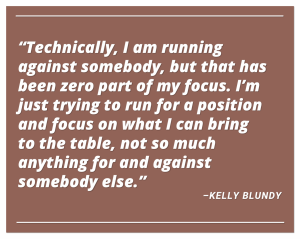 On what voters should know
On what voters should know
When she decided to run, Blundy said it was “for the community” and “wasn’t to go against anybody.” She described an interest in getting involved with the district and focus on “what I can bring to the table, not so much anything for and against somebody else.”
She said her experience in the medical field and as a mom of young kids provided her with “a different perspective on things,” that could be brought to the Board as a whole.
Read full response
JM: The Board has clarified that they’re kind of going to step back from the future decisions and let the administration and student body handle some of the steps in choosing a new mascot. You are running against another candidate, incumbent David Steinberg. I am not seeking any attacks. Are you interested in highlighting any differences between you and Mr. Steinberg that you would like the public to know?
KB: It was interesting. I actually had met with [Superintendent Erik] Gundersen, and he asked me the same question. And my answer was that I think he’s done a great job. I’m just a different perspective on things, and it’s not to say that my perspectives are different from his, it’s just with my background, with young kids coming in, it’s just… It’s totally no disrespect or attack on him.
I just really wanted to do this for the community. It wasn’t to go against anybody. I always really wanted to get involved in other things like I have with the state of New Jersey [doctor’s board] already. I have nothing against him to say. Technically, I am running against somebody, but that has been zero part of my focus. I’m just trying to run for a position and focus on what I can bring to the table, not so much anything for and against somebody else.
 On her favorite pastimes
On her favorite pastimes
Blundy’s favorite pastime is “seeing the world” and doing it with her family. Her kids, who she said are now “hitting that age where they’re so stinking cute and funny,” had begun to accompany her on her travels before Covid hit.
She also likes to golf. “It’s the only time I can focus on two things, which is keeping my head down and my eye on the ball,” Blundy said. “I do work a lot and just love traveling.”
Read full response
JM: What are your favorite pastimes?
KB: Besides kids… My kids are now hitting that age where they’re so stinking cute and funny. They crack me up everyday. I do love to travel; obviously, that has been completely halted, but last year I was starting to take my kids to places wheare we actually had a lot of things planned this year. Just seeing the world and doing it with my family is huge.
I also love golf because it’s the only time I can focus on two things, which is keeping my head down and my eye on the ball. Other than that, just family time. I do work a lot and just love traveling. I was actually going to bring my kids back to Guatemala with me, and we were working on the next mission trip –– we were going to go to Thailand. So hopefully we will still get to do those things.
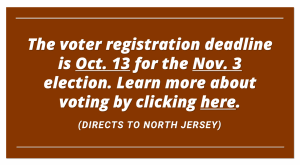
Read another profile:
 Why Blundy is running
Why Blundy is running On her involvement with Hills
On her involvement with Hills On her experience
On her experience On school reopening and student wellness
On school reopening and student wellness On responding to Covid-19 and future crises
On responding to Covid-19 and future crises On a possible return to all-virtual instruction
On a possible return to all-virtual instruction On the budget and Board transparency
On the budget and Board transparency
 On being the ‘new kid’
On being the ‘new kid’ On equity and inclusivity
On equity and inclusivity
 On the mascot removal
On the mascot removal On what voters should know
On what voters should know On her favorite pastimes
On her favorite pastimes